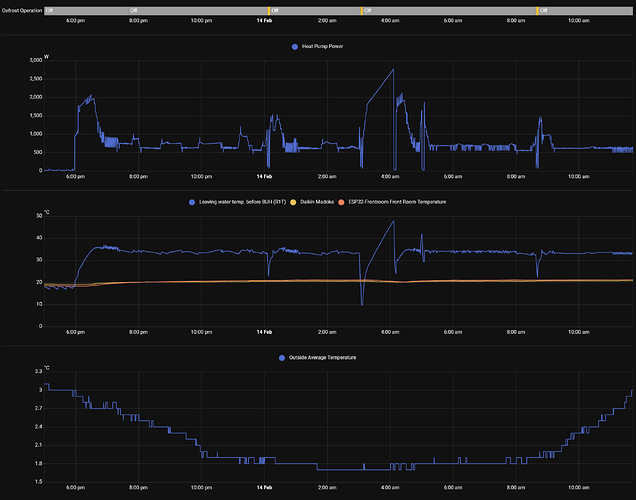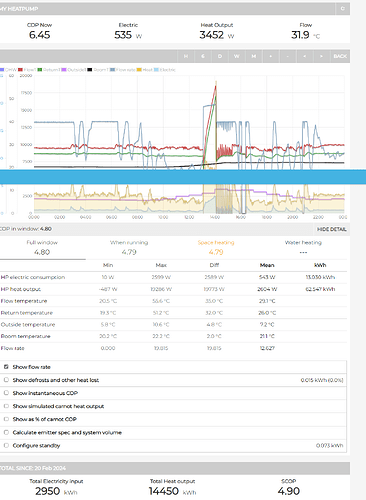Hi @ebyard just noticed your original post, do you have a buffer tank and separate pump?
There’s a red volumizer tank in the attic and a grey coloured buffer above the DHW tank - could be the other way around, not 100% sure. The only other pump aside from the HP’s one is the D2 pump.
Are there 4 pipes going into the Grey Tank? if this is the case, I think you may have a buffer tank and two pumps, one inside the Monoblock and one for the system, we have one pump in the monobloc and a volumizer (grey tank) with two pipes that helps with defrost and adding volume to the system. Apologies if i have confused the flow rate advise -
Hi @ebyard It may be worth sharing your radiator schedule, flow plan, and system design, picking up information from other threads, ur system pulling 2kW at steady state is not ideal…
Here is our 8kW unit overnight, 3 defrost and a DHW cycle
Defrost, Power, LWT, Room Temp and Outside Temp
Hope this helps?
Also check out this 8kW system as a benchmark @KnightPhoenix
https://emoncms.org/app/view?name=MyHeatpump&readkey=bfd97700dd78658dedd70ff6670b453c
Hi @tiger-cook and @ebyard. Very interesting notes. I see that my flow rate ( which appears to me to be invariable-ish) around the 7 seems to the same as yours @tiger_cook as does my flow rate, mine might be a little lower. @ebyard I’m a little puzzled because , based on your video, you have very high lwt at 49 degrees? I’m assuming that it was octopus who came and did something to adjust your flow rate?
One thing I’m not clear about from the HPIN video and yours I guess @ebyard is presumably the higher the flow rate the more cost to run, otherwise it’d be a no brainer to up the flow rate? So if a higher flow rate gives more kw, does it cost more kWh? Also does the higher flow rate push up the LWT?
At this moment my LWT is 29, my return wt is 24/my flow rate is 6.9L/m and the living room is at 18c, which is comfortable for me. Outside temp is 6c . But if tweaking the flow up gave a higher temp for no additional cost, well then…
So I think my system is set to a delta t of 10 and I’m currently at 5, which I understand is a good ish place to be?
So to recap, if flow speed determines kw produced does it have more consumption too and if so is it directly proportional to the heat increase? Plus any other input would be helpful.
Just as a bye the way I had a totally wasted hour trying to get an answer on this today with Daikin, whose final answer was, we don’t know talk to your installer!
Increased flow rate means that the pump is working harder, which means your electricity consumption will increase. No free lunch here I’m afraid.
Hi Terry,
7 litres per minute is the minimum flow rate of these heat pumps.
You cannot adjust the flow rate directly.
Your dT is set at 10c.
The heat pump will set the flow rate to achieve this based on the flow temperature set.
As your flow temperature is set at 29c then the return temperature needs to be 19c.
Your emitters can’t do this at the lowest flow rate so it just sits there at 7 litres per minute.
Up the flow temperature and eventually you will see the flow rate increase.
That is, of course, within the maximum output of the heat pump.
If you want higher flow rates and flow temperatures below 40c then you will need to reduce the requested dT.
You cannot directly control the flow rate on a Daikin heat pump, only the dT
Setting a big dT pretty much always keeps the flow rate at the minimum of 7 litres per minute.
On the bigger (9kW+) versions the minimum flow rate is around 10.5 litres per minute.
@matt-drummer , I understood from the installers that the DT setting of 10 allowed for maximum flexibility. So that it could range from 10 to say 3 or less and that 5 is a good place to be. So on today’s figures I have a 5, which is ok? I’m always conscious of the issue that a lot of people raise about this heat pump not liking to go down to 25 and the Daikin technical people have previously sort of confirmed that. So I tweaked my curve to have 25 at about 20c. Thus, in theory once the weather is around 15c - 16c I can turn the heating off and avoid getting into the heat pumps cranky zone.
I should have added is that I’m running on pure weather comp so I get what it gives based on the curve. I’ve tweaked the curve as noted elsewhere, but I also have an offset, which has been running at -5, but just now I reduced it to -4.
Sam, that makes sense to me, so the question is what is the incremental cost that @ebyard is paying for his 18l/m and is it proportional or a bargain?
Hi Terry,
The dT on a Daikin heat pump is fixed at whatever you set it to.
There is no flexibility, it does not vary once the heat pump is running.
A dT of 10c is a dT of 10c and will always result in the lowest flow rate at the sort of flow temperatures we run.
There are three modes of operation, ufh, fan coils and radiators.
In ufh and fan coils you can set the dT at whatever you want.
In the radiator setting the minimum dT is 10c but you can increase it.
These heat pumps are not happy below 30c, particularly when it is warmer outside and I fond I need to increase the flow temperature as it gets warmer to maintain efficiency.
Of course, that is not necessary if the efficiency is not the most important thing.
But i choose to run most efficiently and turn it off when it gets too hot.
This thread goes into it in great detail …
To summarise, if pump energy was free, then an infinite flow rate would be optimal. This reduces the dT to nothing, but the important point is that it minimises the flow temperature, and the lower the flow temperature the higher the heat pump efficiency.
Hi again Terry,
The flow rate does not have any real affect on the cost of running the heat pump.
The circulation pump uses more electricity at the higher flow rate, obviously.
But the main affect on electricity consumption is the heat being produced.
The heat pump could be producing 5kW of heat at a flow rate of 18lpm and a dT of 3c
Or it could be producing 5kW of heat at a flow rate of 9lpm and a dT of 6c
The heat is the same and the electricity cost is the same more or less.
Daikin heat pumps are all about the dT between flow and return temperatures.
There is no direct flow rate control and they don’t gradually build flow temperature.
They just get to the requested flow temperature and adjust flow rate to get the requested dT.
They will overshoot the flow temperature if it is set and necessary, otherwise they just run or cycle if the return temperature rises too much and the overshoot has been used in full.
It is all about the return temperature and dT.
The flow temperature is largely irrelevant, generally going too low just results in the same or even more electricity use and poor efficiency as a result.
but the important point is that it minimises the flow temperature, and the lower the flow temperature the higher the heat pump efficiency.
Hi Alun,
Not with a Daikin, there’s a limit and if you go below it the efficiency gets worse.
They are not happy below 30c and generally need a bit more once the outside temperature is 10c+
That is, to get the best efficiency
Oh, I can believe that. It all depends on the control algorithms and physical limitations of the design. But the basic point stands, it’s thermodynamics, innit.
Matt, let’s make sure I’m not being completely dense here. In practice the delivered delta T is the difference between the LWT and the returning WT, is that right?
So earlier my LWT was 29 and my RWT was 24. I reduced my offset from -5 to -4 and at this moment my LWT is 31 and my RWT is still 24. So have I not moved from a dt of 5 to a dt 7? Notwithstanding the ‘set’ DT.
Yes Alun, you are correct, within the limitations of the particular heat pump.
Daikins do not like low flow temperatures, believe me, I have tried!
I set up my whole system to run at 25c when warm but my heat pump says no!
Hi Terry,
Yes, you are correct, dT is the difference between LWT and RWT in this context.
I don’t know what your settings are.
I suspect you are on radiators with a requested dT of 10c, maybe check?
All that has happened is that you have increased your LWT from 29c to 31c
The RWT has stayed at 24c so now you see an increase in dT from 5c to 7c.
I suspect your flow rate is still 7lpm.
What has happened is that your heat output has increases as you are now flowing 7lpm at a dT of 7c instead of 7lpm at a dT of 5c
If you continue to increase the LWT to something like 8c you will see your flow rate increase and the DT will stay at 10c as you increase further until you reach the maximum out put of the heat pump.
The problem with a Daikin is that you can only get a stable flow rate by setting an unachievably high dT, otherwise the flow rate will start to fluctuate.
Everything becomes unstable, especially at low flow temperatures and smaller Dt’s
The flow temperature hunts, the flow rate is moving al the time and the electricity input hunts.
All this results in a loss of efficiency.
This is mine with a lower dT, the flow rate is completely out of control as is the heat output. Add in Madoka control and modulation and it is just an unstable mess.
Surely me increasing the flow temp by 1c increases the heat, why does the widening of the delta t increase the heat? Maybe in pure weather dependent mode the flow rate is always at the minimum, apart from if it’s been off and restarts, but once it’s into a run it just keeps it steady and increases LWT if more heat is needed?
No, Terry.
The amount of heat delivered comes from the volume of water and the change in its temperature.
The actual temperatures are irrelevant.
Water flowing at 100c with a return of 95c at 10lpm is the same amount of heat as water flowing at 30c with a return of 25c at 10lpm.
Your flow rate is at the minimum because you are not achieving your set dT.
What is your dT set at?
What mode are you running in?
Radiators, fan coils or ufh?
I would guess radiators?


